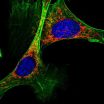(Press-News.org) Scientists have developed a sophisticated computer modelling simulation to explore how cells of the fruit fly react to changes in the environment.
The research, published today in the science journal Cell, is part of an on-going study at The Universities of Manchester and Sheffield that is investigating how external environmental factors impact on health and disease.
The model shows how cells of the fruit fly communicate with each other during its development. Dr Martin Baron, who led the research, said: "The work is a really nice example of researchers from different disciplines of maths and biology working together to tackle challenging problems."
The current phase of the study aims to understand how temperature interacts with cell signalling networks during development. Flies are able to develop normally across a wide range of temperatures and it is not understood how this is achieved.
The combined disciplines approach was undertaken because the complexity of development involves numerous components that are interconnected with each other in networks of cell to cell communication pathways, whose outcomes are difficult to predict without computer simulations.
The fruit fly is a commonly used in lab work because, although its development is relatively simple, around 75% of known human disease genes have a recognisable match in the genome of fruit flies which means they can be used to study the fundamental biology behind complex conditions such as neurodegeneration or cancer.
Baron said: "it is exciting that the computer model was able to make predictions that we could test by going back to the fly experiments to investigate the effects of different mutations which alter the components of the cells. It shows us that the model is working well and provides a solid basis on which to develop its sophistication further."
The next phase will see the team research how the cell signalling network adjusts and responds to other environmental changes such as nutrition. Baron says "There is a lot of interest in how environmental inputs influence our health and disease by interacting with our genetic makeup. Our initial studies have already shown that changes to the adult fly's diet can also affect how cells inside a fly communicate with each other and produce responses in certain fly tissues. This is a promising avenue for future studies".
Baron explains that there are wider implications for understanding human health and disease: "Many different types of signal control normal development but when some of these signals are mis-activated they can result in the formation of tumours."
"What we've learnt from studying the flies" said Baron, "is that some communication signals can arise in different ways and this means that, in cancer, mis-activation of these signals can also occur by different routes. This is important because it can help us to understand how to stop mis-activation from occurring."
INFORMATION: END
Computer models helping unravel the science of life?
2014-05-22
ELSE PRESS RELEASES FROM THIS DATE:
Supportive tissue in tumors hinders, rather than helps, pancreatic cancer
2014-05-22
HOUSTON – Fibrous tissue long suspected of making pancreatic cancer worse actually supports an immune attack that slows tumor progression but cannot overcome it, scientists at The University of Texas MD Anderson Cancer Center report in the journal Cancer Cell.
"This supportive tissue that's abundant in pancreatic cancer tumors is not a traitor as we thought but rather an ally that is fighting to the end. It's a losing battle with cancer cells, but progression is much faster without their constant resistance," said study senior author Raghu Kalluri, Ph.D., M.D., chair ...
Blocking pain receptors extends lifespan, boosts metabolism in mice
2014-05-22
Blocking a pain receptor in mice not only extends their lifespan, it also gives them a more youthful metabolism, including an improved insulin response that allows them to deal better with high blood sugar.
"We think that blocking this pain receptor and pathway could be very, very useful not only for relieving pain, but for improving lifespan and metabolic health, and in particular for treating diabetes and obesity in humans," said Andrew Dillin, a professor of molecular and cell biology at the University of California, Berkeley, and senior author of a new paper describing ...
One molecule to block both pain and itch
2014-05-22
Duke University researchers have found an antibody that simultaneously blocks the sensations of pain and itching in studies with mice.
The new antibody works by targeting the voltage-sensitive sodium channels in the cell membrane of neurons. The results appear online on May 22 in Cell.
Voltage-sensitive sodium channels control the flow of sodium ions through the neuron's membrane. These channels open and close by responding to the electric current or action potential of the cells. One particular type of sodium channel, called the Nav1.7 subtype, is responsible for ...
Deciphered the process through which cells optimize metabolism to burn sugars or fats
2014-05-22
To guarantee efficient use of nutrients, cells have systems that permit them to capture and transport the available nutrient molecules to their interior. But if several nutrients are available, cells can select those that are of most interest and discard undesired molecules.
Inside cells, nutrients are conducted to the mitochondria, the specialized cell organelles in which nutrients are combusted to release the energy held in their chemical bonds. Both sugars (glucose) and fats (fatty acids) are 'burned' in mitochondria, but these organelles need to adjust their molecular ...
New insight into stem cell development
2014-05-22
The world has great expectations that stem cell research one day will revolutionize medicine. But in order to exploit the potential of stem cells, we need to understand how their development is regulated. Now researchers from University of Southern Denmark offer new insight.
Stem cells are cells that are able to develop into different specialized cell types with specific functions in the body. In adult humans these cells play an important role in tissue regeneration. The potential to act as repair cells can be exploited for disease control of e.g. Parkinson's or diabetes, ...
Study: Some pancreatic cancer treatments may be going after the wrong targets
2014-05-22
ANN ARBOR, Mich. — New research represents a significant change in the understanding of how pancreatic cancer grows – and how it might be defeated.
Unlike other types of cancer, pancreatic cancer produces a lot of scar tissue and inflammation. For years, researchers believed that this scar tissue, called desmoplasia, helped the tumor grow, and they've designed treatments to attack this.
But new research led by Andrew D. Rhim, M.D., from the University of Michigan Comprehensive Cancer Center, finds that when you eliminate desmoplasia, tumors grow even more quickly and ...
'I can' mentality goes long way after childbirth
2014-05-22
The way a woman feels about tackling everyday physical activities, including exercise, may be a predictor of how much weight she'll retain years after childbirth says a Michigan State University professor.
James Pivarnik, a professor of kinesiology and epidemiology at MSU, co-led a study that followed 56 women during pregnancy and measured their physical activity levels, along with barriers to exercise and the ability to overcome them.
Six years later, the research team followed up with more than half of the participants and found that the women who considered themselves ...
What is being said in the media and academic literature about neurostimulation?
2014-05-22
Over the past several decades, neurostimulation techniques such as transcranial direct current stimulation (tDCS) have gradually gained favour in the public eye. In a new report, published yesterday in the prestigious scientific journal Neuron, IRCM ethics experts raise important questions about the rising tide of tDCS coverage in the media, while regulatory action is lacking and ethical issues need to be addressed.
TDCS is a non-invasive form of neurostimulation, in which constant, low current is delivered directly to areas of the brain using small electrodes. Originally ...
EuroPCR 2014 examines whether science translates into practice with new session format
2014-05-22
22 May 2014, Paris, France: The value of analysing published clinical trials and the benefit of informed discussion were highlighted yesterday when the ACCOAST trial data were discussed in a new session format—Will this trial change my practice?— at EuroPCR 2014. ACCOAST trial results demonstrate that pre-treatment with prasugrel in NSTEMI patients undergoing percutaneous coronary intervention (PCI) is inferior to treatment with the drug after angiography. Several other trials are also being scrutinised in the same format, which ends with a discussion with the audience ...
New details on microtubules and how the anti-cancer drug Taxol works
2014-05-22
A pathway to the design of even more effective versions of the powerful anti-cancer drug Taxol has been opened with the most detailed look ever at the assembly and disassembly of microtubules, tiny fibers of tubulin protein that form the cytoskeletons of living cells and play a crucial role in mitosis. Through a combination of high-resolution cryo-electron microscopy (cryo-EM) and new methodology for image analysis and structure interpretation, researchers with the Lawrence Berkeley National Laboratory (Berkeley Lab) and the University of California (UC) Berkeley have produced ...



